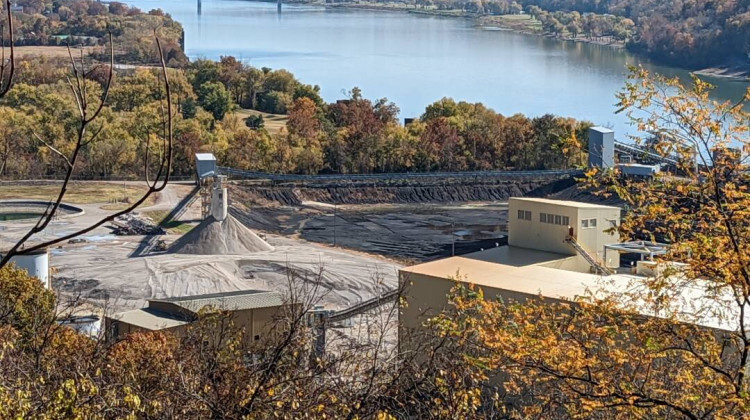Climate change in Indiana will mean more rain in the winter and spring. Because there are fewer plants at that time of year to soak up all of that water, that will mean more flooding. As we reported back in May, many Hoosiers don’t have flood insurance.
Other than buying flood insurance, we wanted to look into how cities in Indiana and their residents can prepare for more flooding in the state.
First, here are some examples from the Environmental Resilience Institute of what cities around Indiana are doing to prevent flooding.
Bloomington Invested in Green Infrastructure
Miller-Showers Park is nestled in between two of the busiest streets in Bloomington — College and Walnut. As a result, it’s not the quietest park, but it serves a unique purpose.
Linda Thompson is the city’s senior environmental planner. She says the plants and retention ponds help to slow and filter runoff from Bloomington’s downtown before it reaches sensitive natural areas.
“The highest place in the city is not far from here and, as we all know, water drains downhill. And so it comes past this area and then it continues on into a creek and a wetland,” Thompson says.
Like many Indiana cities, Bloomington experienced a lot of flooding this past spring. Thompson says if the park weren’t here, flooding in the area would probably have been worse than it was.
Though the park’s main job is to slow the water down, it still has a lot of the typical city park features. There are trees, native plants, and even fish.

Kelsey Thetonia is the MS4 coordinator for the City of Bloomington — which means she works to prevent stormwater pollution in the city. MS4 stands for Municipal Separate, Sewer, Storm, Systems.
Thetonia says the city recently raised its residential stormwater fee by $3.25 a month and part of the money will go to dredging the ponds at Miller-Showers.
“All the sand and grit that has come off the roads has settled in here over the past nine or so years. And so like any other pond around town, it does need to be maintained,” Thetonia says.
Of course, the park isn’t the only green infrastructure in Bloomington. Another example is the living wall — a wall covered with greenery — on the Monroe County Parking Garage on the corner of Morton and 8th streets.
Thompson says the plants on the side of the garage not only look beautiful, but also keep the wall of the garage cooler and reduce heat in the area. She says the plants likely also sequester some carbon emissions.
South Bend Has “Smart Sewers”
Like more than a 100 other cities in Indiana, South Bend has what’s called a combined sewer system. That’s where sewage, industrial waste, and stormwater is collected together and sent to a treatment plant.
Kieran Fahey is the director of the long term control plan for combined sewer overflows for the City of South Bend. He says back when these sewers were built in the 19th and 20th centuries, the environment wasn’t the first thing on people’s minds.
“As bad as it sounds nowadays to us and as horrible as an idea as it is, it was better at the time than the alternative which was you know, to backup into people's homes, bathrooms, basements — that kind of thing,” Fahey says.
But during heavy rains, the system can’t handle all the excess water — so all of that stormwater, sewage, and industrial waste gets sent to nearby waterways through what’s called a combined sewer overflow. For that reason, the Environmental Protection Agency calls these overflows a “major water pollution concern.” If the river this wastewater is flowing into gets too high, you have flooding problems.
In 2004, researchers at the University of Notre Dame (who have now formed a company called EmNet) used South Bend as a test case for some new technology. They placed sensors in the city’s sewer system that can alert the city to when a sewer line is about to reach capacity and send some of that wastewater to other, less stressed lines.
Fahey says it’s made a big impact. He says in 2008, South Bend had about 30 inches of rain leading to roughly 2 billion gallons of overflow. Last year, the city saw twice as much rain, but because of the smart sewers, only saw a quarter of the overflow.
Fahey says the city has also been able to fix parts of the sewers that need repairs before they become major problems. But he says it’s not perfect — it can’t handle some of the extreme weather events we’ve been seeing due to climate change.
“This is not a system designed to be able to mitigate against, you know, hurricane style rainfall events or anything like that — but up to a point it can be very beneficial,” Fahey says.
Tipton Made A Flooding Resilience Plan
Tipton County is a pretty rural area and so its flooding issues are different than the usual urban flooding you might see elsewhere in Indiana. Its county seat, the city of Tipton, has a little more than 5,000 people.
County surveyor Jason Henderson says more farmers in the area are using a network of underground plastic tubes to drain their land. He says 30 or 40 years ago, it would have taken a farmer two or three days to drain an 80-acre field. Now it can be done in a day.
“That's all well and good, but eventually there's a point where that water is discharging into something — and that something unfortunately passes through a populated area,” Henderson says.
That something is Big Cicero Creek, which runs straight through the city of Tipton. Henderson says in 1992, Tipton, Boone, Clinton, and Hamilton counties formed a drainage board to help with flooding and erosion along the steep banks of the creek.
Then, the 2013 flood happened. According to the Associated Press, it caused more than $2.5 million in property damage in the city of Tipton alone. Henderson says it got the drainage board to think bigger.
“It made us realize the drainage is getting faster to that entity and it does cause more flooding. So we start thinking how you could mitigate it?” he says.
That led to the City of Tipton getting the FEMA RiskMAP Mitigation Grant in 2015 which helped it develop a flooding resilience plan — the first of its kind in Indiana. Henderson says the plan helped the city to change its laws so that it discourages certain types of uses on the floodplain.
“Our hospital is in the floodplain and it received some flooding during that [2013] event. That was a 100 year flood event. I mean, it was extremely large,” he says. “Our school corporation, they lay in it and it destroyed about 30 cars in the parking lot because of the flooding.”
Henderson says the hard part is remembering to prepare for these emergencies that don’t happen every day — so each spring he puts a flood watch notice in the local newspaper.
Contact Rebecca at rthiele@iu.edu or follow her on Twitter at @beckythiele.
Indiana Environmental reporting is supported by the Environmental Resilience Institute, an Indiana University Grand Challenge project developing Indiana-specific projections and informed responses to problems of environmental change.
 DONATE
DONATE








 Support WFYI. We can't do it without you.
Support WFYI. We can't do it without you.